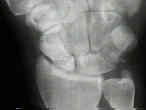- Proximal Pole Frx:
- Bone Grafting of Scaphoid Non Unions:
- Scaphoid Nonunions:
- Radiographs:
- need to determine whether there is AVN of scaphoid:
- classic signs of AVN include:
- ground-glass appearance or increased bone density;
- loss of trabecular pattern;
- cystic changes;
- subchondral collapse and fragmentation;
- some authors have questioned whether or not radiographic appearance of proximal pole accurately correlates with AVN;
- in majority of these cases, the proximal fragment appears relatively dense radiographically, indicating some degree of ischemia;
- this is accentuated after wrist has been immobilized as the rest of the carpi become osteoporotic;
- AVN of scaphoid is often difficult to diagnose radiographically and therefore it is usually necessary to assess vascularity
of the proximal pole at the time of surgery;
- absence of punctate bleeding in the proximal fragment (after debridement) is the best indicator of AVN;
- Pre-Operative Considerations:
- these fracture can be technically difficult to manage and may carry a poor overall prognosis;
- there is seldom any significant carpal deformity or collapse, so that cancellous bone grafting alone is normally sufficient;
- care should be taken with curettage or resection of pseudarthrosis to ensure that there remains sufficient bone
in the proximal fragment to allow for satisfactory internal fixation;
- proximal fragment nearly always appears somewhat unhealthy at operation
- occasionally fragment is soft and necrotic, in which case reconstruction is not possible;
- more commonly, however, the bone is hard and sclerotic;
- if proximal pole demonstrates punctate bleeding at the time of surgery then expected rate of healing is over 90%;
- if there appears to be some possibility of revascularization, bone grafting and screw fixation should always be attempted;
- radial styloidectomy:
- may be contra-indicated in established scaphoid non union since it may further destabilize the wrist joint;
- Non-union of the scaphoid. Revascularization of the proximal pole with implantatin of a vascular bundle and bone-grafting.
- involves iliac corticocancellous grafting and implantation of second dorsal metacarpal artery into the proximal scaphoid;
- surgical approach:
- volar approach is made only if there has been a previous approach on that side of the wrist;
- dorsal approach to the scaphoid involves longitudinal incision from Lister's to the base of the thumb CMC joint (just ulnar to EPL tendon);
- dissection thru the subQ tissues (avoiding sensory nerves) and develop the interval between the ECRL and EPL;
- incise the wrist capsule overlying the scaphoid;
- debridement of non-union;
- sharply remove all fibrous tissue and sclerotic bone surfaces;
- assessment of vascularity;
- look for punctate bleeding points (w/ tourniquet elevated or w/ tourniquet released when there is minimal bleeding);
- when vascularity is present, implantation of the second dorsal metacarpal artery will not be present (and only bone grafting is necessary);
- bone grafting:
- using a burr or currett, create a cigar shaped hole 5 mm in diameter in the proximal fragment and a trapezoidal shaped notch
in the distal fragment to accomodate the graft (and to help lock it in place);
- insert an appropriately sized corticocancellous bone graft w/ the cortical side pointing dorsally;
- K wire Fixation:
- 1-2 K wires are inserted along the longitudinal axis of the scaphoid, parallel to the graft;
- arterial implantation:
- implantation site lies slightly ulnar to the center of the proximal pole;
- drill hole is made in a dorsal to plantar direction;
- second metacarpal artery is mobilized and is brought thru the drill hole;
- the wrist capsule is left open where it is adjacent to the artery
Non-union of the scaphoid. Revascularization of the proximal pole with implantatin of a vascular bundle and bone-grafting.
Dorsal approach to scaphoid nonunion.
Retrograde Herbert screw fixation for treatment of proximal pole scaphoid nonunions
Prognostic factors in the treatment of carpal scaphoid nonunions.
The effect of avascular necrosis on Russe bone grafting for scaphoid nonunion.
Treatment of scaphoid nonunions: Quantitative meta-analysis of the literature


